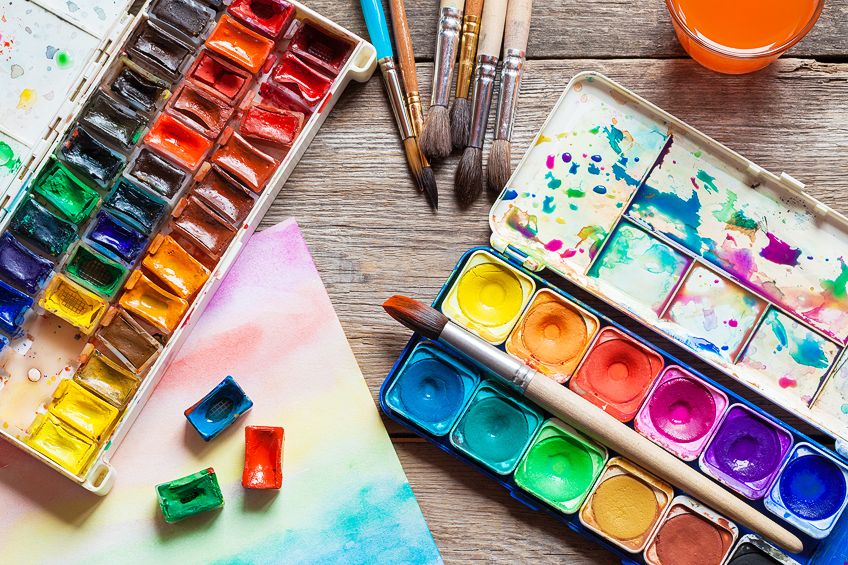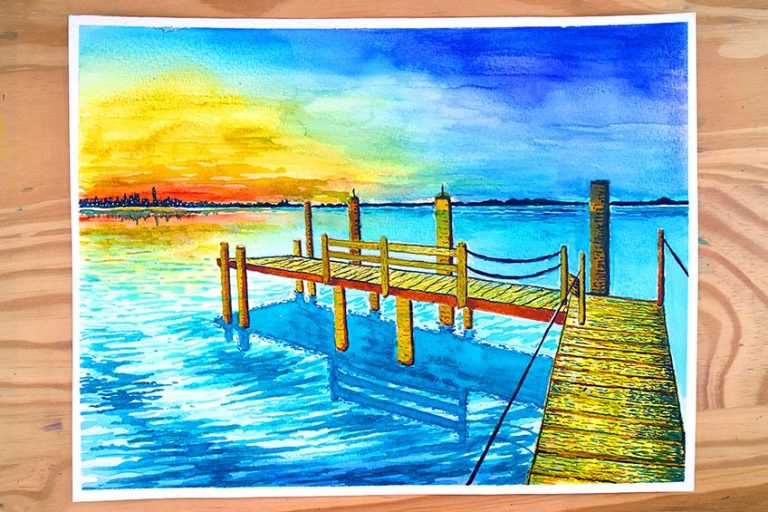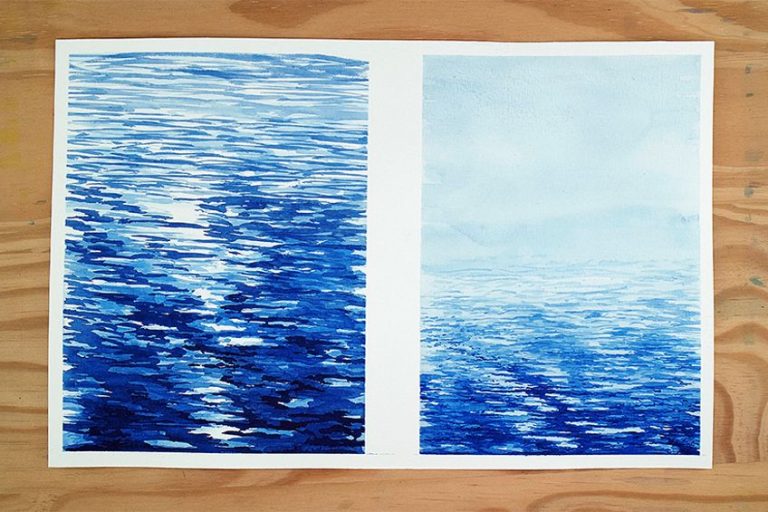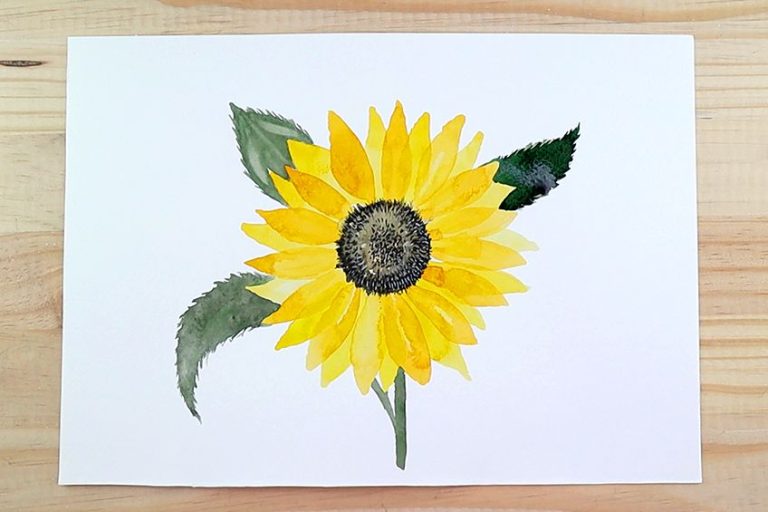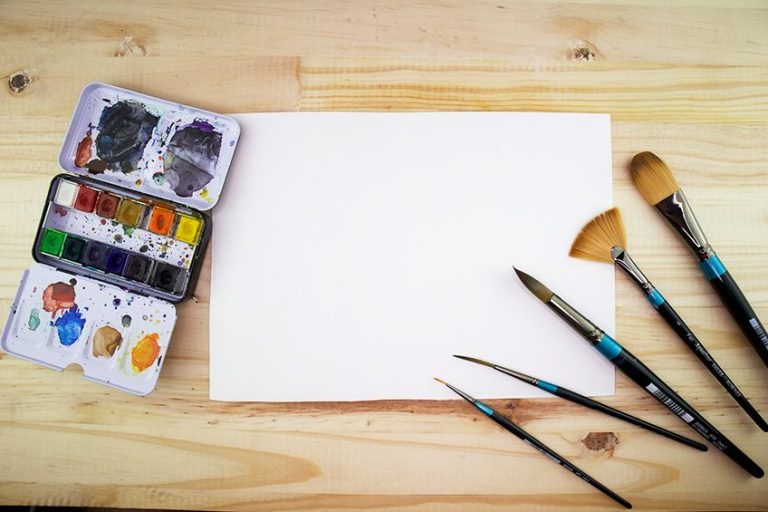Watercolor Painting Tips – How to Paint With Watercolor for Beginners
The world of art is thousands of years old, and watercolors have been a major part of it since the late 1400s. It is easy to see why. The subtle combination of water and paint creates delicate works of art and makes the gentle mix of colors appear to dance across the paper. But watercolor painting can be challenging, especially if you are just starting out, so in this article, we are going to discuss how to paint with watercolors for beginners. Once you have mastered these watercolor painting tips you will understand why watercolors are as enduring as they are endearing.
Table of Contents
What You Will Need to Get Started
A lot of budding arts are reluctant to try watercolor painting because they are afraid that it will be too difficult to master. Getting started is often the hardest part, so we are here to tell you that in fact, that is one of the easiest parts! All you will need are a few inexpensive tools, namely watercolor paint, water, a palette, and a paintbrush, and you will be ready to go. We will start by having a look at the supplies you will need, then we will discuss watercolor techniques for beginners in more depth.
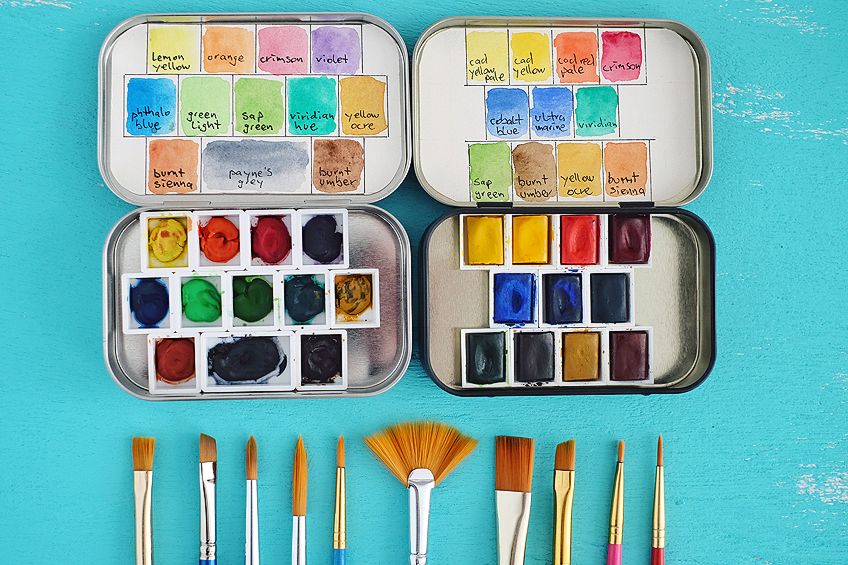
Watercolor Paints
Watercolor paint comes in liquids, tubes, and little blocks of color called pans. You can use any of these, but most people like the pans. They are portable, compact, and are available in a variety of colors. In fact, all the colors you will ever need are contained in one set, so there is no need for you to buy individual tubes or jars of color. That said, you really only need the following eight to begin with.
With these colors, you will be able to master the art of color mixing which will stand you in good stead as you become more proficient at watercolor painting.
| Color | HEX Code | Shade |
| Pyrrol Scarlet | #DA2829 | |
| Quinacridone Rose | #C32474 | |
| New Gamboge | #E49B0F | |
| Hansa Yellow Light | #E9D66B | |
| French Ultramarine | #2522CA | |
| Phthalo Blue | #000F89 | |
| Titanium White | #FFFFFF | |
| Lunar Black | #080808 |
Watercolor Brushes
Typically, watercolor brushes are made up of long, soft hairs that are ideal for working with water. The best brushes are made of natural hair, such as squirrel or sable, but they are very expensive. Fortunately, there are top-quality synthetic brushes available that are considerably cheaper. There are countless shapes and sizes of brushes on the market, but you will need a couple of large brushes for laying down a wash (in other words, layers of paint laid down with water), and a few round brushes of varying sizes for more detailed work.

The size of the brush is indicated by a number, and the higher the number, the bigger the brush. We recommend you invest in three round brushes, a #6, a #10, and a #12, and a couple of flat one-inch brushes to use when you are going to lay down a lot of color. You will use the round brushes for detailed work.
It is important that you take care of your brushes and ensure they maintain their shape and softness. When you have finished using them, wash them with gentle soap and warm water, and rinse them until all the paint has been washed away. Then gently mold the brushes back into shape and store them upright to dry.
Watercolor Paper
The paper you select can make or break your painting. The surface of the paper must be able to absorb water and be thick enough to withstand numerous washes of color. Watercolor paper is thick and heavy, the ideal weight being a minimum of 140lbs (300 gms). It is manufactured with a process called “sizing”, where additives like gelatin or synthetic sizing are added to the paper, enabling it to absorb water properly.
This also ensures that the paper stays flat whilst you are painting.
An Artist’s Palette
Artists’ palettes are readily available from art and craft stores. Some have special indentations in which to mix your colors, while others have a flat surface. You can even use a dinner plate if you like since watercolors mix well on china (and your plate can be easily washed afterward).

Paper Towels
Paper towels are a must-have when you are watercolor painting because it can get messy, for example, if you spill paint on the table (or yourself!). You can also use paper towels to mop up any extra water that has spread out over your paper, and clean around the more detailed parts of your painting. You could also use Q-Tips for this finicky job, too.
Painter’s Tape
If you have ever wondered how artists are able to create a perfect, paint-free border around their paintings, this is the answer: painter’s tape. Or masking tape, if you prefer. Use the tape to block off the borders around the edges of the page, and make sure it is stuck fast so that no paint seeps underneath it.
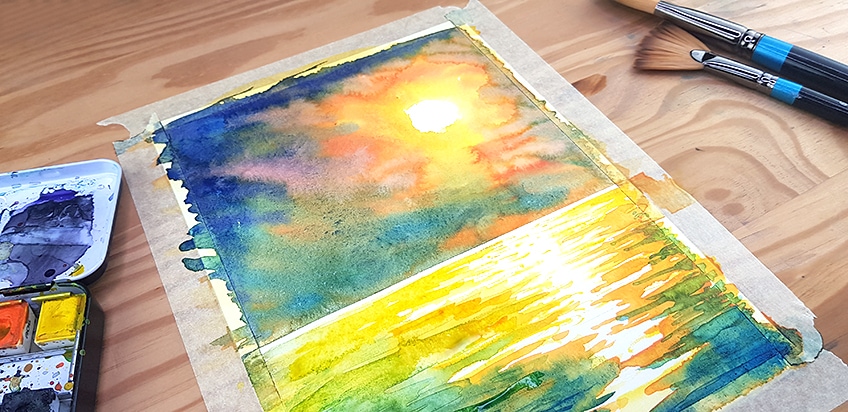
How to Mix Watercolor Paints
Although there will be times when the colors you want are amongst the eight colors you have selected, more often than not you will need to mix colors together to create the specific color you need. As we have said, you can make just about any color you like by mixing these particular colors.
Mixing colors is very easy, and it is fun to experiment with different mixes to see what colors you come up with. There are four easy steps to follow.
Step 1
Before you do anything else, you need to decide on the color you want. To begin, we need to go back to kindergarten where we first learned how to mix colors, such as blue and red to make purple, and blue and yellow to make green. The same principles will apply now. Let us say you have decided you want to create a deep purple color.
Step 2
Dip your brush in the water and then into the pyrrol scarlet (red), and dab it onto your palette. Depending on the size of the area you will be painting, you may need to add more paint. Although we have suggested that you start with the red color, you could just as easily start with the blue (French ultramarine). In this case, neither color is dominant over the other.

Step 3
Clean your brush by swirling it in the water and repeat the process with the French ultramarine, and dab it next to the pyrrol Scarlet. By doing this, you will be able to see that you have equal amounts of red and blue that will make the perfect purple when you mix the two colors together.
Step 4
Clean your brush again until there is no color left on it, then gently mix the red and blue paints together. As you see the purple color start to emerge you will be able to tell if it is the correct hue, in other words, if it is as dark or as light as you want it. If you want it darker, add a little more red or blue. You could also add a touch of lunar black, but be very careful because black can easily dominate the other color and make it look more black than purple. Conversely, if you want a lighter purple, you could either add a bit more water or a small dab of titanium white.
Follow the same steps for mixing other colors, for example, green. You could mix new gamboge (which is yellow) with phthalo blue to create a warm green color. Why not also experiment with Hansa yellow light and French ultramarine to make up a different green?
More Watercolor Painting Tips
Now that you have assembled your paper and brushes, and have mixed the additional colors you need, it is time to learn how to paint with watercolors for beginners. The combination of the reflective white paper and the delicate, luminous colors make a finished watercolor painting an enchanting piece of artwork. In this section we will discuss all the watercolor tips and tricks you will need to create your own masterpiece.

First Draw Your Picture
You cannot paint a picture in watercolors without having a picture to work on. Thus, the first step is to softly draw your picture using a light pencil, such as 2H or 3H. Proper artists’ pencils are water-resistant and will not spread across the paper or stain it when water is applied.
Bear in mind that you will not be able to erase the pencil marks once the watercolor paint has dried, so be sure not to apply too much pressure when sketching out your picture.
Put the Borders in Place
Your painting will not be finished properly unless it has a clear border around it. As we mentioned earlier, you will use your artists’ or masking tape to create the border around the page. Press down hard on the tape so that it sticks firmly to the paper and will not allow any paint or water to run underneath it.
Paint From Light to Dark
When you are painting with any other medium besides watercolors, for example, oils and acrylics, you would paint the dark colors before the light. It is the opposite way around with watercolors because you work from light to dark. This is because all the light, or luminosity, comes from the white paper, not from the paint itself. Thus, if you paint from dark to light, you will not see any light colors because they will have been absorbed by the darker colors.
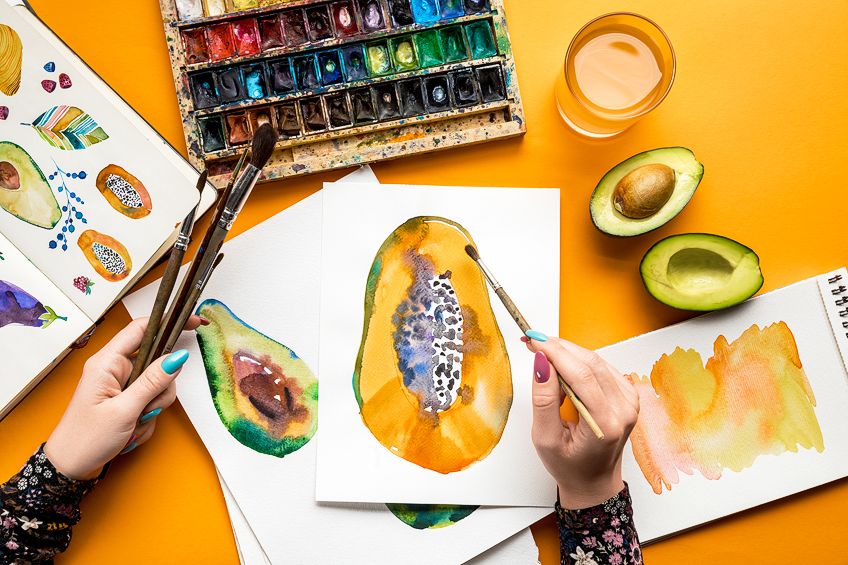
Working With Negative Space
This is a concept unique to watercolor painting, and it goes hand in hand with painting from light to dark. The technique ensures that the parts of the painting closest to the person looking at it are lighter, while the parts that are further away are darker.
To create negative space, you would outline the particular part of the painting that you want to stand out.
For example, you could create a negative space with a flower or a tree, where you would gradually fade the paint around it and thus surround it with a dark color. The darker the color around the picture, the lighter it will appear to the viewer.
Wet and Dry Painting Techniques
It goes without saying that watercolors are a water-based medium, and that means you can change the darkness of the colors as well as the saturation (in other words, the brightness of the color) by using water.
If you want a defined and crisp edge to the subject you are painting, you would either apply wet paint to dry paper, or to dry paint. By doing this, the paint will only be laid down where you apply it with the brush.
On the other hand, if you want to create a more fluid, undefined effect, you would apply clean water to the paper and then add your paint to it. While there is less control with this method, the result is a more abstract and interesting look.

Fixing Your Mistakes
Every artist makes mistakes, even the professionals, so you need not be overly concerned when you need to fix a mistake. Although you cannot erase your mistake completely the way you can with an eraser on pencil marks, you can lift the color off the paper. Wait until the paint has dried, then with a clean and watery brush, paint the shape you want to erase or lift. Let the “painted” area set, then gently wipe it away using a paper towel. You will see the color lifting in the shape you just painted. Allow the area to dry before you paint over it again.
With these watercolor painting tips, we have attempted to debunk the myth that watercolor painting is too difficult for beginners and that you should not try it unless you are proficient in other painting mediums. With the watercolor tips we have shown you, you will be fully equipped to embark on a watercolor painting project of your own. And remember, although you may not get it right the first time, half the fun is experimenting as you go along, and learning from your mistakes. Why not start watercolor painting today?
Frequently Asked Questions
Do I Need to Buy a Lot of Watercolor Paints to Begin With?
No, not at all. You can either buy a pan set of paints, or tubes of red, yellow, and blue paints. Try to get warm colors as well as cool colors, because the different tones of each color will produce different results. As we mentioned earlier in the article, you only need eight colors, including black and white, to start with.
If I Make a Mistake, Will I Have to Discard My Painting?
No, because you can easily fix your mistakes by the process of lifting the color. All you need to do is paint over the error with water and wait for the paint to lift from the page into the water. Then use a paper towel to dry the area. It should be completely dried before you attempt to paint over it.
How Can I Make a Part of My Picture Stand Out From the Rest of the Painting?
This technique is known as painting with negative space. To create it, outline the part you want to stand out, and gradually fade the paint away from it. You are effectively making the picture stand out by surrounding it with a darker color. It will therefore be light on dark, and that technique will always make the lighter part “pop”. This is one of the most important watercolor painting tips, so put as much practice as you can into mastering this technique.
In 2005, Charlene completed her Wellness Diplomas in Therapeutic Aromatherapy and Reflexology from the International School of Reflexology and Meridian Therapy. She worked for a company offering corporate wellness programs for a couple of years, before opening up her own therapy practice. It was in 2015 that a friend, who was a digital marketer, asked her to join her company as a content creator, and this is where she found her excitement for writing.
Since joining the content writing world, she has gained a lot of experience over the years writing on a diverse selection of topics, from beauty, health, wellness, travel, and more. Due to various circumstances, she had to close her therapy practice and is now a full-time freelance writer. Being a creative person, she could not pass up the opportunity to contribute to the Art in Context team, where is was in her element, writing about a variety of art and craft topics. Contributing articles for over three years now, her knowledge in this area has grown, and she has gotten to explore her creativity and improve her research and writing skills.
Charlene Lewis has been working for artincontext.org since the relaunch in 2020. She is an experienced writer and mainly focuses on the topics of color theory, painting and drawing.
Learn more about Charlene Lewis and the Art in Context Team.
Cite this Article
Charlene, Lewis, “Watercolor Painting Tips – How to Paint With Watercolor for Beginners.” Art in Context. October 4, 2021. URL: https://artincontext.org/watercolor-painting-tips/
Lewis, C. (2021, 4 October). Watercolor Painting Tips – How to Paint With Watercolor for Beginners. Art in Context. https://artincontext.org/watercolor-painting-tips/
Lewis, Charlene. “Watercolor Painting Tips – How to Paint With Watercolor for Beginners.” Art in Context, October 4, 2021. https://artincontext.org/watercolor-painting-tips/.


